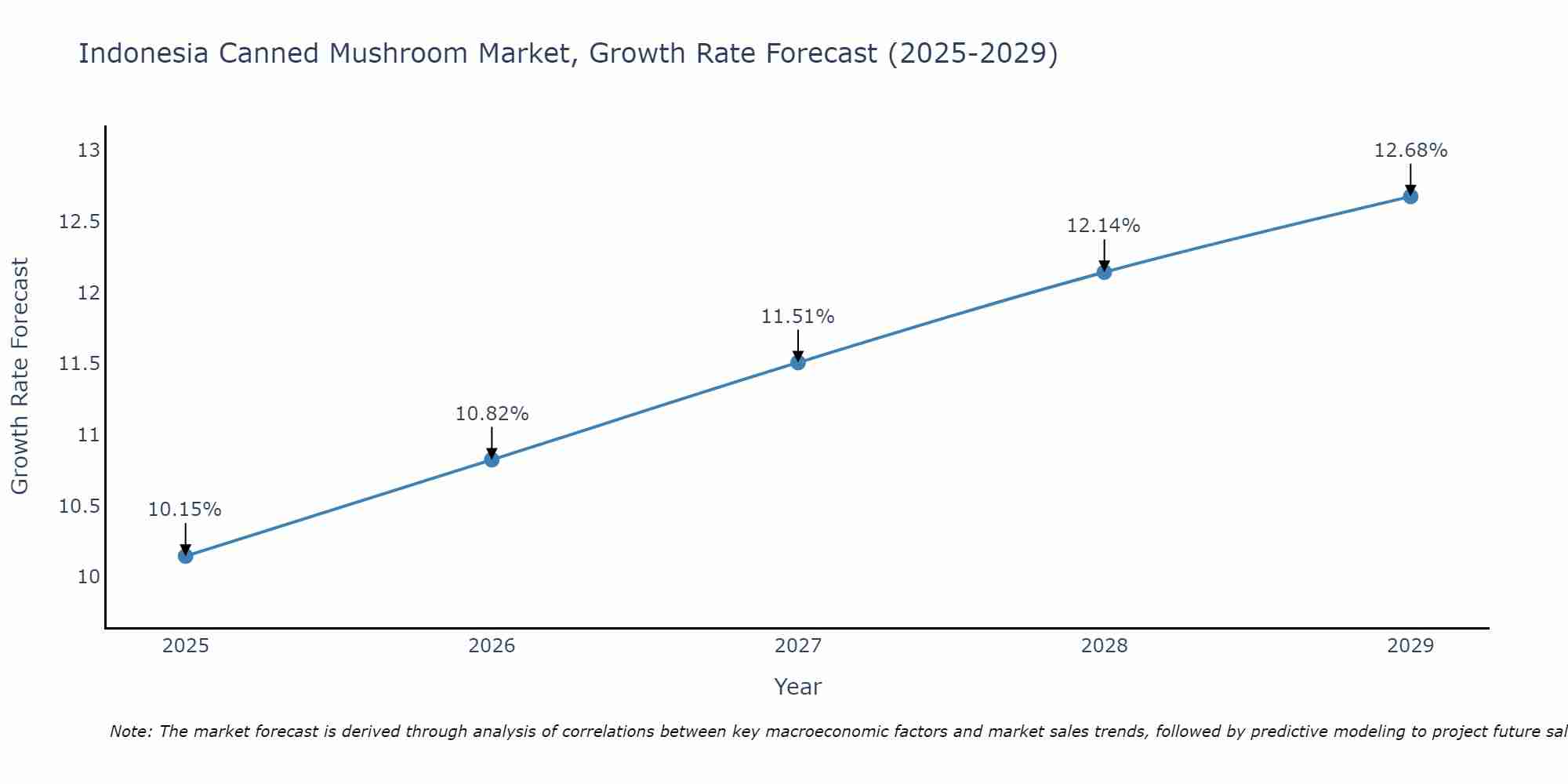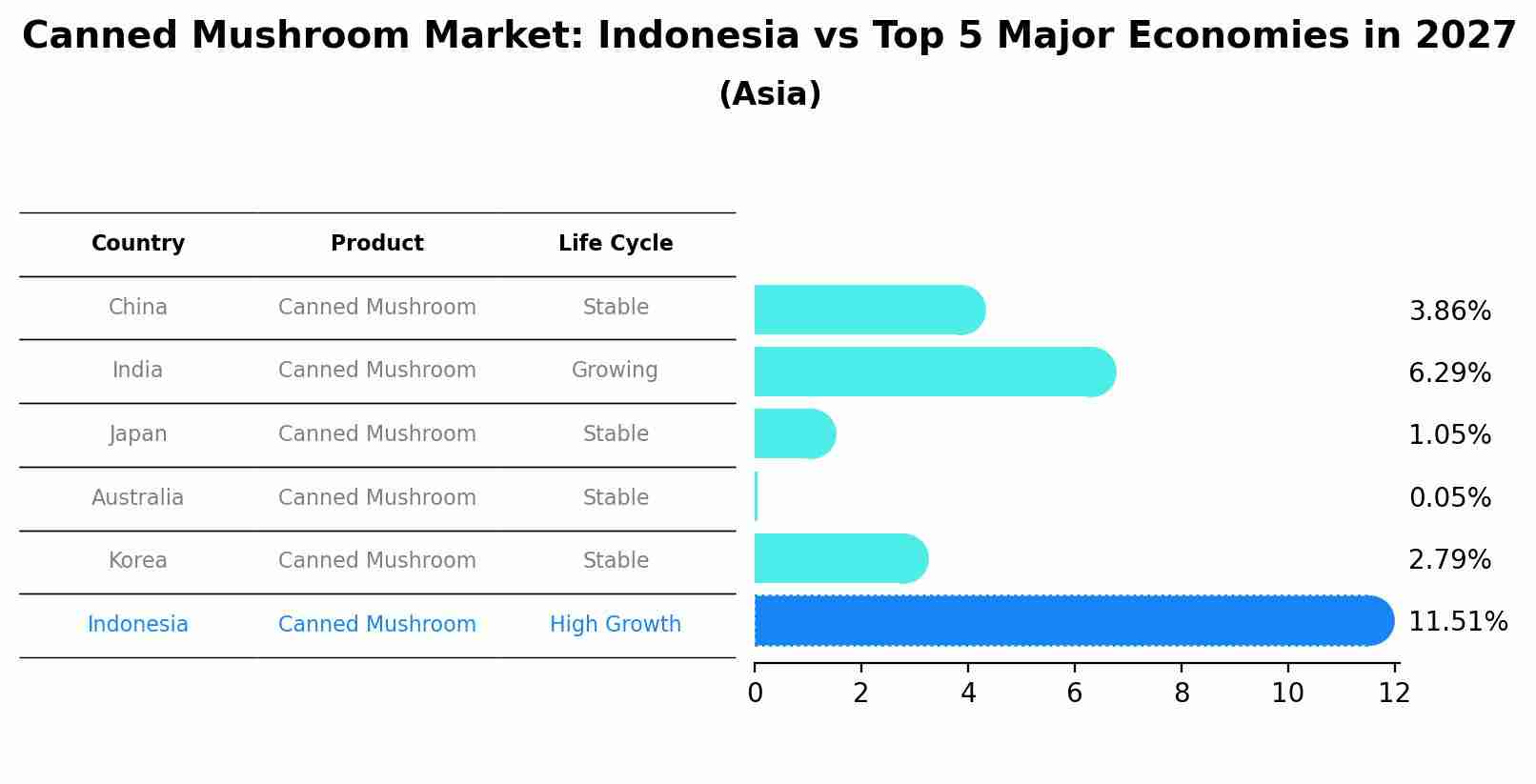Indonesia Canned Mushroom Market (2025-2031) Outlook | Growth, Analysis, Value, Forecast, Trends, Companies, Size, Share, Revenue & Industry
| Product Code: ETC108647 | Publication Date: Jul 2023 | Updated Date: Aug 2025 | Product Type: Report | |
| Publisher: 6Wresearch | No. of Pages: 70 | No. of Figures: 35 | No. of Tables: 5 | |
Indonesia Canned Mushroom Market Size Growth Rate
The Indonesia Canned Mushroom Market is poised for steady growth rate improvements from 2025 to 2029. The growth rate starts at 10.15% in 2025 and reaches 12.68% by 2029.

Canned Mushroom Market: Indonesia vs Top 5 Major Economies in 2027 (Asia)
The Canned Mushroom market in Indonesia is projected to grow at a high growth rate of 11.51% by 2027, within the Asia region led by China, along with other countries like India, Japan, Australia and South Korea, collectively shaping a dynamic and evolving market environment driven by innovation and increasing adoption of emerging technologies.

Indonesia Canned Mushroom MarketSynopsis
Indonesia is one of the largest producers and consumers of canned mushrooms in the world. The country has witnessed an increase in demand for canned mushroom products with rising health consciousness among Indonesias, who are increasingly opting for low-fat and high-fiber foods such as mushrooms. Indonesia canned mushroom market has grown significantly over the past few years due to increased consumption from both domestic and international buyers.
Market Trends
The Indonesia canned mushroom market is driven by several factors, including increasing disposable income, growing popularity of convenience food items, health benefits associated with mushrooms, rising vegan population, and favorable government policies promoting organic food production. In addition, there has been a shift from traditional methods of preserving food towards more convenient ways that involve canning or freezing fresh ingredients. This trend is driving up sales of processed food products such as canned mushrooms in Indonesia. Furthermore, various flavors have been added to existing product lines which has further boosted their appeal amongst consumers looking for variety within this segment.
Market Drivers
Some key drivers behind Indonesia strong growth in the canned mushroom industry include increasing disposable incomes among households; expanding urbanization and modernized lifestyles; growing demand for convenience foods; potential health benefits associated with consuming fungi-based diets; the rise of veganism throughout Indonesia; and popular government initiatives promoting organic farming practices across the archipelago nation.. Additionally, promotional campaigns run by companies along with discounts offered during peak seasons have encouraged customers to purchase these products frequently leading to higher sales figures year on year.
COVID-19 Impact on the Market
The Indonesia canned mushroom market has been severely impacted by the COVID-19 pandemic. Exports of canned mushrooms to countries such as China, Japan and South Korea have decreased significantly due to supply chain disruptions. Moreover, a decrease in demand for these products from restaurants and hotels has resulted in lower sales volumes for producers in Indonesia. Additionally, travel restrictions imposed due to the pandemic have made it difficult for manufacturers to access raw materials needed for production.
Challenges of the Market
One of the main challenges facing the Indonesia canned mushroom industry is a lack of technological advancements or modern equipment used in processing facilities which are necessary for food safety. As most factories rely on outdated machinery, there is an increased risk of contamination and spoilage when producing canned mushrooms which can lead to losses in revenue and damage consumer confidence. Furthermore, there are difficulties associated with obtaining high quality raw materials within Indonesia borders as well as meeting international standards that must be met before exporting products abroad; this limits export opportunities available to Indonesia producers operating within this sector.
Industry Key Players
Some key players operating within the Indonesia Canned Mushroom Market include PT Indofood Sukses Makmur Tbk., PT Mayora Indah Tbk., PT Nutrifood Indonesia and PT Multi Bintang Indonesia (Heineken). These companies produce various types of packaged dried/canned mushrooms that are sold both domestically and internationally; they also provide contract packaging services along with private label manufacturing options depending on customer requirements.
Key Highlights of the Report:
- Indonesia Canned Mushroom Market Outlook
- Market Size of Indonesia Canned Mushroom Market, 2024
- Forecast of Indonesia Canned Mushroom Market, 2031
- Historical Data and Forecast of Indonesia Canned Mushroom Revenues & Volume for the Period 2021-2031
- Indonesia Canned Mushroom Market Trend Evolution
- Indonesia Canned Mushroom Market Drivers and Challenges
- Indonesia Canned Mushroom Price Trends
- Indonesia Canned Mushroom Porter's Five Forces
- Indonesia Canned Mushroom Industry Life Cycle
- Historical Data and Forecast of Indonesia Canned Mushroom Market Revenues & Volume By Product for the Period 2021-2031
- Historical Data and Forecast of Indonesia Canned Mushroom Market Revenues & Volume By Button for the Period 2021-2031
- Historical Data and Forecast of Indonesia Canned Mushroom Market Revenues & Volume By Shiitake for the Period 2021-2031
- Historical Data and Forecast of Indonesia Canned Mushroom Market Revenues & Volume By Oyster for the Period 2021-2031
- Historical Data and Forecast of Indonesia Canned Mushroom Market Revenues & Volume By Morel for the Period 2021-2031
- Historical Data and Forecast of Indonesia Canned Mushroom Market Revenues & Volume By Other for the Period 2021-2031
- Historical Data and Forecast of Indonesia Canned Mushroom Market Revenues & Volume By Application for the Period 2021-2031
- Historical Data and Forecast of Indonesia Canned Mushroom Market Revenues & Volume By Household for the Period 2021-2031
- Historical Data and Forecast of Indonesia Canned Mushroom Market Revenues & Volume By Restaurants for the Period 2021-2031
- Indonesia Canned Mushroom Import Export Trade Statistics
- Market Opportunity Assessment By Product
- Market Opportunity Assessment By Application
- Indonesia Canned Mushroom Top Companies Market Share
- Indonesia Canned Mushroom Competitive Benchmarking By Technical and Operational Parameters
- Indonesia Canned Mushroom Company Profiles
- Indonesia Canned Mushroom Key Strategic Recommendations
Frequently Asked Questions About the Market Study (FAQs):
1 Executive Summary |
2 Introduction |
2.1 Key Highlights of the Report |
2.2 Report Description |
2.3 Market Scope & Segmentation |
2.4 Research Methodology |
2.5 Assumptions |
3 Indonesia Canned Mushroom Market Overview |
3.1 Indonesia Country Macro Economic Indicators |
3.2 Indonesia Canned Mushroom Market Revenues & Volume, 2021 & 2031F |
3.3 Indonesia Canned Mushroom Market - Industry Life Cycle |
3.4 Indonesia Canned Mushroom Market - Porter's Five Forces |
3.5 Indonesia Canned Mushroom Market Revenues & Volume Share, By Product, 2021 & 2031F |
3.6 Indonesia Canned Mushroom Market Revenues & Volume Share, By Application, 2021 & 2031F |
4 Indonesia Canned Mushroom Market Dynamics |
4.1 Impact Analysis |
4.2 Market Drivers |
4.2.1 Increasing consumer awareness about the health benefits of mushrooms |
4.2.2 Growth in the food processing industry in Indonesia |
4.2.3 Rising demand for convenient and ready-to-eat food products |
4.3 Market Restraints |
4.3.1 Seasonal availability and dependency on weather conditions for mushroom cultivation |
4.3.2 Price fluctuations of raw materials impacting production costs |
4.3.3 Competition from fresh mushroom market and other canned food products |
5 Indonesia Canned Mushroom Market Trends |
6 Indonesia Canned Mushroom Market, By Types |
6.1 Indonesia Canned Mushroom Market, By Product |
6.1.1 Overview and Analysis |
6.1.2 Indonesia Canned Mushroom Market Revenues & Volume, By Product, 2021-2031F |
6.1.3 Indonesia Canned Mushroom Market Revenues & Volume, By Button, 2021-2031F |
6.1.4 Indonesia Canned Mushroom Market Revenues & Volume, By Shiitake, 2021-2031F |
6.1.5 Indonesia Canned Mushroom Market Revenues & Volume, By Oyster, 2021-2031F |
6.1.6 Indonesia Canned Mushroom Market Revenues & Volume, By Morel, 2021-2031F |
6.1.7 Indonesia Canned Mushroom Market Revenues & Volume, By Other, 2021-2031F |
6.2 Indonesia Canned Mushroom Market, By Application |
6.2.1 Overview and Analysis |
6.2.2 Indonesia Canned Mushroom Market Revenues & Volume, By Household, 2021-2031F |
6.2.3 Indonesia Canned Mushroom Market Revenues & Volume, By Restaurants, 2021-2031F |
7 Indonesia Canned Mushroom Market Import-Export Trade Statistics |
7.1 Indonesia Canned Mushroom Market Export to Major Countries |
7.2 Indonesia Canned Mushroom Market Imports from Major Countries |
8 Indonesia Canned Mushroom Market Key Performance Indicators |
8.1 Percentage increase in the number of mushroom processing facilities in Indonesia |
8.2 Consumer sentiment towards canned mushroom products through surveys or focus groups |
8.3 Growth in the number of food retail outlets stocking canned mushroom products |
8.4 Adoption rate of innovative packaging solutions for canned mushroom products |
8.5 Percentage of repeat purchases or customer loyalty for canned mushroom brands |
9 Indonesia Canned Mushroom Market - Opportunity Assessment |
9.1 Indonesia Canned Mushroom Market Opportunity Assessment, By Product, 2021 & 2031F |
9.2 Indonesia Canned Mushroom Market Opportunity Assessment, By Application, 2021 & 2031F |
10 Indonesia Canned Mushroom Market - Competitive Landscape |
10.1 Indonesia Canned Mushroom Market Revenue Share, By Companies, 2024 |
10.2 Indonesia Canned Mushroom Market Competitive Benchmarking, By Operating and Technical Parameters |
11 Company Profiles |
12 Recommendations |
13 Disclaimer |
- Single User License$ 1,995
- Department License$ 2,400
- Site License$ 3,120
- Global License$ 3,795
Search
Related Reports
- Portugal Electronic Document Management Market (2025-2031) | Strategy, Consumer Insights, Analysis, Investment Trends, Opportunities, Growth, Size, Share, Industry, Revenue, Segments, Value, Segmentation, Supply, Forecast, Restraints, Outlook, Competition, Drivers, Trends, Demand, Pricing Analysis, Competitive, Strategic Insights, Companies, Challenges
- France Electronic Document Management Market (2025-2031) | Strategy, Consumer Insights, Analysis, Investment Trends, Opportunities, Growth, Size, Share, Industry, Revenue, Segments, Value, Segmentation, Supply, Forecast, Restraints, Outlook, Competition, Drivers, Trends, Demand, Pricing Analysis, Competitive, Strategic Insights, Companies, Challenges
- Portugal Occupational Health & Safety Services Market (2025-2031) | Strategy, Consumer Insights, Analysis, Investment Trends, Opportunities, Growth, Size, Share, Industry, Revenue, Segments, Value, Segmentation, Supply, Forecast, Restraints, Outlook, Competition, Drivers, Trends, Demand, Pricing Analysis, Competitive, Strategic Insights, Companies, Challenges
- Netherlands Occupational Health and Safety Services Market (2025-2031) | Strategy, Consumer Insights, Analysis, Investment Trends, Opportunities, Growth, Size, Share, Industry, Revenue, Segments, Value, Segmentation, Supply, Forecast, Restraints, Outlook, Competition, Drivers, Trends, Demand, Pricing Analysis, Competitive, Strategic Insights, Companies, Challenges
- Belgium and Luxembourg Facility Management Market (2025-2031) | Strategy, Consumer Insights, Analysis, Investment Trends, Opportunities, Growth, Size, Share, Industry, Revenue, Segments, Value, Segmentation, Supply, Forecast, Restraints, Outlook, Competition, Drivers, Trends, Demand, Pricing Analysis, Competitive, Strategic Insights, Companies, Challenges
- Russia Women Intimate Apparel Market (2025-2031) | Strategy, Consumer Insights, Analysis, Investment Trends, Opportunities, Growth, Size, Share, Industry, Revenue, Segments, Value, Segmentation, Supply, Forecast, Restraints, Outlook, Competition, Drivers, Trends, Demand, Pricing Analysis, Competitive, Strategic Insights, Companies, Challenges
- Africa Chocolate Market (2025-2031) | Size, Share, Trends, Growth, Revenue, Analysis, Forecast, industry & Outlook
- Global Hydroxychloroquine And Chloroquine Market (2025-2031) | Industry, Trends, Size, Outlook, Growth, Value, Companies, Revenue, Analysis, Share, Forecast
- Saudi Arabia Plant Maintenance Market (2025-2031) | Industry, Size, Growth, Revenue, Value, Companies, Forecast, Analysis, Share & Trends
- Taiwan Electric Truck Market (2025-2031) | Outlook, Industry, Revenue, Size, Forecast, Growth, Analysis, Share, Companies, Value & Trends
Industry Events and Analyst Meet
Our Clients
Whitepaper
- Middle East & Africa Commercial Security Market Click here to view more.
- Middle East & Africa Fire Safety Systems & Equipment Market Click here to view more.
- GCC Drone Market Click here to view more.
- Middle East Lighting Fixture Market Click here to view more.
- GCC Physical & Perimeter Security Market Click here to view more.
6WResearch In News
- Doha a strategic location for EV manufacturing hub: IPA Qatar
- Demand for luxury TVs surging in the GCC, says Samsung
- Empowering Growth: The Thriving Journey of Bangladesh’s Cable Industry
- Demand for luxury TVs surging in the GCC, says Samsung
- Video call with a traditional healer? Once unthinkable, it’s now common in South Africa
- Intelligent Buildings To Smooth GCC’s Path To Net Zero













